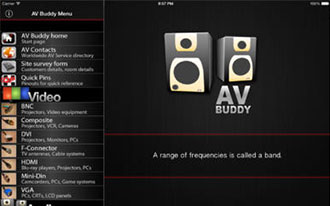AV Buddy Pro: An In Depth Review
 How many of you are still walking into your site surveys with a bag full of tools? You have your light meter, your SPL meter and, most importantly, your clipboard. Just please tell me that you don’t have a pocket protector. While all those tools served us very well in the past, and have their uses in certain places, they limit collaboration between you, your customers and your colleagues.
How many of you are still walking into your site surveys with a bag full of tools? You have your light meter, your SPL meter and, most importantly, your clipboard. Just please tell me that you don’t have a pocket protector. While all those tools served us very well in the past, and have their uses in certain places, they limit collaboration between you, your customers and your colleagues.
AV Buddy Pro is a top notch tool that will allow you to get rid of most of that equipment and carry around only your phone and/or your tablet. The app starts out with a fill-in site survey form. The form includes all the basic information on client identification, but goes into detail in what you find at the site. You can enter parking information, loading dock information and whether you need special access to get into buildings. It has spots for your room details, such as wall and ceiling construction along with room dimensions. The survey allows for you to enter pictures taken on site with the built in camera of your device.
The other strong feature of AV Buddy is the calculations that it can perform. The basic calculation is throw distance. While this is certainly not difficult to figure out, it is often something that people want to know on the spot. If you know what type of projector you are using in a project, AV Buddy may have the model built into the app. Currently, it can calculate the throw distance of Barco, Christie, Epson, Mitsubishi, NEC, Sanyo, Sony and Viewsonic. If you don’t use one of those models, you can manually enter the ratios and it will give you the throw distance.
The app also includes calculators for several other very common needed measurements: Image Height, Closest Viewer, Farthest Viewer, Viewer Text, Diagonal of a Screen and Aspect Ratio. Each one of these calculators allow you to simply plug in the appropriate numbers. The really cool aspect of the calculators is that they can automatically enter the data back into the site survey you originally completed.
The app also includes several audio calculators, that are important, but not something that you would usually pull out on a job site or site survey, such as Impedance and PAG/NAG. Those are typically calculations you would do back at the office with your own tools. A few other misc calculators are helpful, such as the converter (for those of us who still don’t understand the metric system), rack unit measurement, and the heat load of a rack. Some of these calculations are helpful at the site, if we are trying to decide where a rack will fit, or the like. An added in tool, that helps during the initial site survey is the SPL meter. In retro-fit applications, it is critical to understand the base amount of noise in a space, before you start planning the audio system.
Finally, there are a few other tools that come in very handy during the installation. The app has a built in set of 24 test patterns. Each test pattern lets you specify what aspect ratio you want to see it in. There are several frequencies for audio testing. Several of these frequencies also allow you to test the L/C/R channels of audio independently.
I use AV Buddy Pro on a regular basis in the course of my job. However, as much as I do like it and use it, I think there are some quirks that need to be worked out. In particular, I sometimes wonder if the inventor (Chris Wright) tried to make too much out of the application. We are missing a standard, electronic site survey form for AV installations. While this app starts to get there, there is too much else weighing it down, which makes it seem cumbersome. If the inventor reads this (and I know he will) perhaps he could consider releasing a version of an app that is just the site survey, with calculators built into the form. An editable form (maybe in Google Docs?) that gets mailed to the user at the end of the survey would be a great start. Right now, the ability to capture an image of the form is nice, but that is not editable.
Finally, I also have to wonder about all the video, audio and control sections of the app. Again, these are very intimidating for a first time user. I believe that pulling these out into a separate tool, perhaps AV Buddy’s Little BlackBook, would be a wise idea. The final set of tools, such as test patterns and audio testing could be put into a third app. This approach would lighten up the app and it would not be so overwhelming the first several times it is used.
In the end, AV Buddy Pro is worth a buy. The app is $4.99 and that’s a steal for what it provides. The AV sales guy who still has a flip phone is not going to buy into using this app, but that may be for the better. It would only frustrate them. For those of us who are daring, and ready to jump into the future and work more easily with our designers and engineers will start using this app, and benefit from the rewards as the quality improves.





